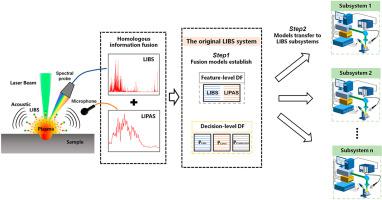当前位置:
X-MOL 学术
›
Anal. Chim. Acta
›
论文详情
Our official English website, www.x-mol.net, welcomes your feedback! (Note: you will need to create a separate account there.)
Enhancement of spectral model transferability in LIBS systems through LIBS-LIPAS fusion technique
Analytica Chimica Acta ( IF 6.2 ) Pub Date : 2024-05-04 , DOI: 10.1016/j.aca.2024.342674 Jiayuan Zhou , Lianbo Guo , Mengsheng Zhang , Weihua Huang , Guangda Wang , Aojun Gong , Yuanchao Liu , Harse Sattar
Analytica Chimica Acta ( IF 6.2 ) Pub Date : 2024-05-04 , DOI: 10.1016/j.aca.2024.342674 Jiayuan Zhou , Lianbo Guo , Mengsheng Zhang , Weihua Huang , Guangda Wang , Aojun Gong , Yuanchao Liu , Harse Sattar

|
Laser-induced breakdown spectroscopy (LIBS) is extensively utilized a range of scientific and industrial detection applications owing to its capability for rapid, in-situ detection. However, conventional LIBS models are often tailored to specific LIBS systems, hindering their transferability between LIBS subsystems. Transfer algorithms can adapt spectral models to subsystems, but require access to the datasets of each subsystem beforehand, followed by making individual adjustments for the dataset of each subsystem. It is clear that a method to enhance the inherent transferability of spectral original models is urgently needed. We proposed an innovative fusion methodology, named laser-induced breakdown spectroscopy fusion laser-induced plasma acoustic spectroscopy (LIBS-LIPAS), to enhance the transferability of support vector machine (SVM) original models across LIBS systems with varying laser beams. The methodology was demonstrated using nickel-based high-temperature alloy samples. Here, the area-full width at half maximum (AFCEI) Composite Evaluation Index was proposed for extracting critical features from LIBS. Further enhancing the transferability of the model, the laser-induced plasma acoustic signal was transformed from the time domain to the frequency domain. Subsequently, the feature-level fusion method was employed to improve the classification accuracy of the transferred LIBS system to 97.8 %. A decision-level fusion approach (amalgamating LIBS, LIPAS, and feature-level fusion models) achieved an exemplary accuracy of 99 %. Finally, the adaptability of the method was demonstrated using titanium alloy samples. In this work, based on plasma radiation models, we simultaneously captured LIBS and LIPAS, and proposed the fusion of these two distinct yet origin-consistent signals, significantly enhancing the transferability of the LIBS original model. The methodology proposed holds significant potential to advance LIBS technology and broaden its applicability in analytical chemistry research and industrial applications.
中文翻译:

通过 LIBS-LIPAS 融合技术增强 LIBS 系统中光谱模型的可转移性
激光诱导击穿光谱 (LIBS) 因其快速原位检测能力而被广泛应用于一系列科学和工业检测应用。然而,传统的 LIBS 模型通常是针对特定的 LIBS 系统定制的,这阻碍了它们在 LIBS 子系统之间的可转移性。传递算法可以使光谱模型适应子系统,但需要事先访问每个子系统的数据集,然后对每个子系统的数据集进行单独调整。显然,迫切需要一种增强光谱原始模型固有可迁移性的方法。我们提出了一种创新的融合方法,称为激光诱导击穿光谱融合激光诱导等离子体声学光谱(LIBS-LIPAS),以增强支持向量机(SVM)原始模型在具有不同激光束的 LIBS 系统中的可转移性。使用镍基高温合金样品演示了该方法。这里,提出了半峰全宽 (AFCEI) 综合评价指数,用于从 LIBS 中提取关键特征。进一步增强模型的可转移性,激光诱导等离子体声信号从时域转换到频域。随后,采用特征级融合方法将转移的LIBS系统的分类精度提高到97.8%。决策级融合方法(合并 LIBS、LIPAS 和特征级融合模型)实现了 99% 的准确率,堪称典范。最后,利用钛合金样品证明了该方法的适应性。在这项工作中,基于等离子体辐射模型,我们同时捕获了LIBS和LIPAS,并提出了这两个不同但起源一致的信号的融合,显着增强了LIBS原始模型的可移植性。所提出的方法对于推进 LIBS 技术并扩大其在分析化学研究和工业应用中的适用性具有巨大潜力。
更新日期:2024-05-04
中文翻译:

通过 LIBS-LIPAS 融合技术增强 LIBS 系统中光谱模型的可转移性
激光诱导击穿光谱 (LIBS) 因其快速原位检测能力而被广泛应用于一系列科学和工业检测应用。然而,传统的 LIBS 模型通常是针对特定的 LIBS 系统定制的,这阻碍了它们在 LIBS 子系统之间的可转移性。传递算法可以使光谱模型适应子系统,但需要事先访问每个子系统的数据集,然后对每个子系统的数据集进行单独调整。显然,迫切需要一种增强光谱原始模型固有可迁移性的方法。我们提出了一种创新的融合方法,称为激光诱导击穿光谱融合激光诱导等离子体声学光谱(LIBS-LIPAS),以增强支持向量机(SVM)原始模型在具有不同激光束的 LIBS 系统中的可转移性。使用镍基高温合金样品演示了该方法。这里,提出了半峰全宽 (AFCEI) 综合评价指数,用于从 LIBS 中提取关键特征。进一步增强模型的可转移性,激光诱导等离子体声信号从时域转换到频域。随后,采用特征级融合方法将转移的LIBS系统的分类精度提高到97.8%。决策级融合方法(合并 LIBS、LIPAS 和特征级融合模型)实现了 99% 的准确率,堪称典范。最后,利用钛合金样品证明了该方法的适应性。在这项工作中,基于等离子体辐射模型,我们同时捕获了LIBS和LIPAS,并提出了这两个不同但起源一致的信号的融合,显着增强了LIBS原始模型的可移植性。所提出的方法对于推进 LIBS 技术并扩大其在分析化学研究和工业应用中的适用性具有巨大潜力。






























 京公网安备 11010802027423号
京公网安备 11010802027423号